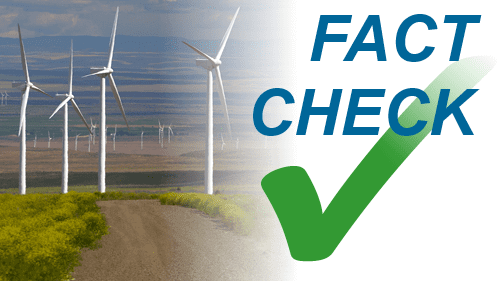Fact Check: FWS eagle take permit applies to number of different industries
While the U.S. Fish and Wildlife Service (FWS) works to finalize plans to update its eagle take permit rule, there continues to be some confusion about the rule, why the rule exists, and who can apply for it.
Top facts about the permit rule
- The permit program promotes eagle conservation.
- The eagle take permit rule was not created for the wind industry, but rather applies to any person or industry who might kill an eagle through the result of an otherwise lawful activity after first taking every step possible to avoid and minimize the threat.
- Whereas wind energy was barely mentioned in the 2009 permit rule, explicit examples in the rule of those sectors for which the permit is applicable include: railroads that routinely strikes birds, utilities power lines that cause disturbances, disruption at ports from vessel traffic, and airports that need to remove eagle nests for safety purposes.
- We expect data in the draft rule to show wind to be a minimal source of the total human-caused impacts to eagles every year.
- In exchange for avoiding, minimizing and fully offsetting the impact through compensatory mitigation, a take permit provides a certain degree of legal and financial certainty to a project proponent, which is essential to any business.
- After the rule was finalized in 2009, the FWS proposed one important change to the permit program in 2012: whereby they extended the maximum permit duration from five years to up to 30 years.
- While that change was ultimately lost through court action, where the judge found the agency did not conduct an appropriate NEPA analysis, the FWS has been publicly noticing and taking comment on potential revisions since 2012.
It’s important to clarify that the ability to obtain a permit is only possible under carefully controlled conditions, including an evaluation of the risk to eagles, implementation of avoidance and minimization measures to reduce that risk and compensatory mitigation to fully offset the impact of a take should it occur. This high standard puts significant pressure on wind farm owners and operators to minimize their impacts to the greatest extent practicable.
Top facts about wind energy and eagles
As a clean energy source, wind is one of the most compatible with wildlife. While eagle fatalities are relatively uncommon, the U.S. wind energy industry does more than any other known mortality source to find ways to reduce its comparatively small impact—and even find ways offset others’ impacts.
- Eagle fatalities occurring at modern wind farms are an exceedingly rare, but extremely unfortunate event the industry takes very seriously.
- These impacts do not occur at every wind farm and where they have been documented are typically an infrequent event.
- An examination of publicly available data of all known eagle fatalities shows collisions with wind turbines at modern wind farms is responsible for less than five percent of all documented human-caused golden eagle deaths.
- Even rarer are impacts on bald eagles, as there are only a small amount of documented instances of fatalities in the entire history of the U.S. wind industry.
- Far more deaths are caused by pesticide application poisoning, illegal shootings, electrocutions, vehicle strikes, lead poisoning, drowning in stock tanks, and other means.
Wind power mitigates its impacts
Building on a legacy of care, the U.S. wind energy industry has proactively worked to minimize the limited impacts it does have on eagles. American wind power has a long history of partnering with regulators and conservation organizations to better understand wind’s effects, and how they can be reduced to the greatest extent possible.
A large percentage of wind energy’s impacts on eagles has historically occurred at a limited number of wind farms in California, which were constructed more than 30 years ago. These are some of the nation’s oldest wind installations, and were constructed long before the relationship between wind and eagles was fully understood.
The good news is that these older sites are being modernized through a process known as re-powering, where numerous smaller, first-generation wind turbines with faster spinning blades are replaced by modern machines, which have a lower risk profile as they are better sited, spaced further apart, and rotate at slower RPMs. Experts estimate that upon completion of the repowering activities eagle fatalities will be reduced by as much as 80 percent at those locations.
Throughout the rest of the country, where more modern machinery and better siting practices have been utilized, impacts to individual eagles are a much rarer event.
Proactive efforts
The U.S. wind energy industry has long supported research on eagle populations and behavior in order to understand and reduce its impacts. It has adopted voluntary guidelines and siting requirements in an effort to be the best possible steward of the land, and detailed environmental impact studies are undertaken before projects are built to ensure that wildlife impacts are minimized to the greatest degree possible. Once projects are constructed, facility owner/operators typically monitor their impacts and consult with agencies on actions that can be taken should higher than anticipated impacts occur.
Lastly, wind energy is the biggest, fastest, cheapest way to reduce carbon pollution that in turn drives climate change, which a number of conservation groups, including the National Wildlife Federation and the National Audubon Society, as well as the vast majority of the scientific community, recognizes as the greatest threat to all bird populations.





